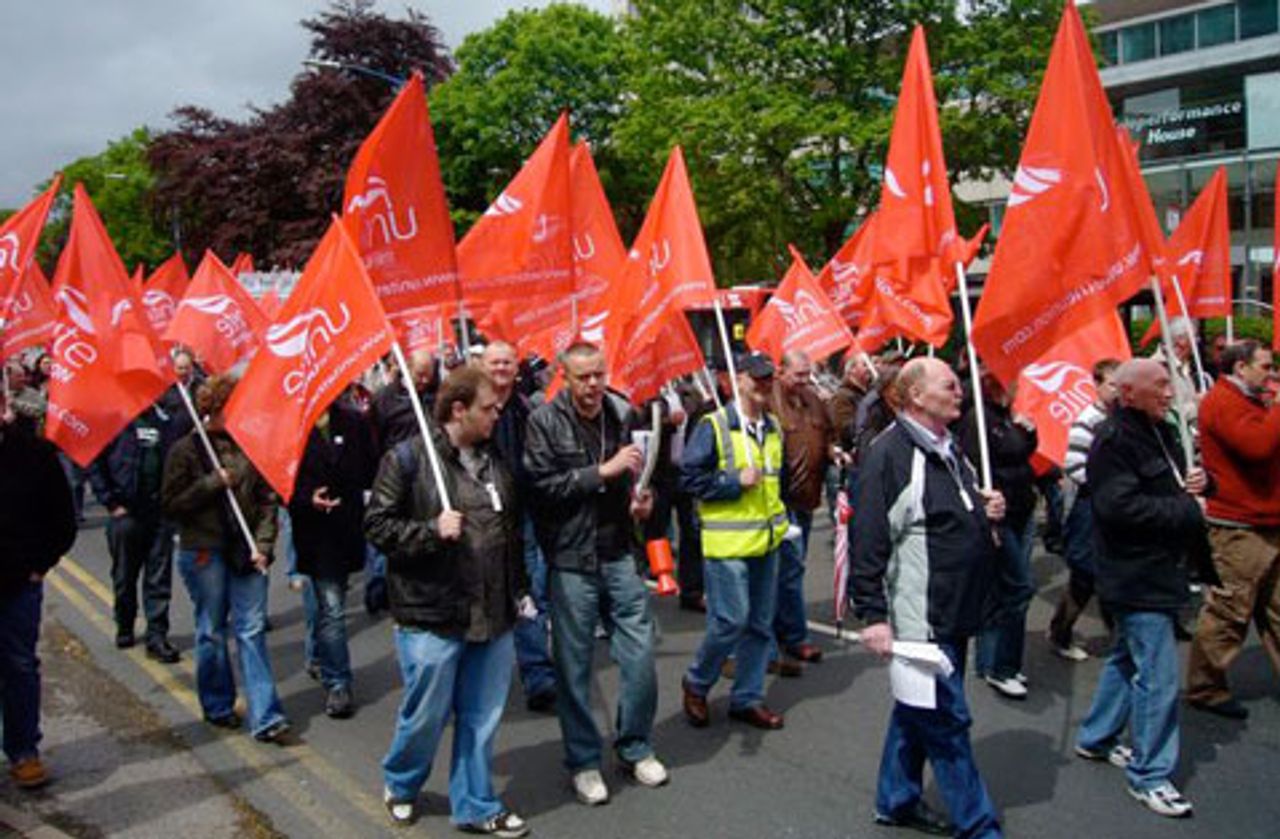On Saturday, Britain’s largest trade union, Unite, organised a demonstration in Birmingham in the West Midlands attended by about 5,000 people. The protest was called under the banner of a “March for Jobs.” Among the speakers at the rally were Trades Union Congress (TUC) leader Brendan Barber and the joint general secretaries of Unite, Tony Woodley and Derek Simpson.
 A section of the march
A section of the marchThe Unite protest was called in response to the huge increase in unemployment in Britain over the past few months. Birmingham in the West Midlands has been hit hard by the increase in unemployment rolls. Many workers employed in the West Midlands auto industry have been laid off.
Unemployment rose by 244,000 in the three months to March. At 2.2 million it is at the highest level since 1996 and is set to reach three million by the end of the year.
On the march were small delegations from the steel firm Corus in Teesside, auto industry workers from Vauxhall, Jaguar Land Rover and LDV and a delegation from United Biscuits. A delegation from the Ford car parts supplier’s Visteon joined the protest. The entire 610-strong Visteon workforce was laid off in March with just minutes notice. Visteon workers have demanded and won redundancy payments after mounting occupation in defiance of their union.
The membership of Unite makes up nearly a third of the 6.5 million trade union members affiliated to the TUC, which gave its official support to the march. Under these conditions, why is it that such a large union was only able to mobilise such a small protest and one made up of a large number of union officials, at a time of mounting job losses and unemployment? Birmingham is the second biggest city in the UK. It sits at the heart of UK manufacturing and has the highest unemployment rate in the country at 9.3 percent. Almost one in 10 people in the region are out of work.
Unite was not even surprised by the low turnout. They told the press that were expecting an attendance of 5,000. The march was in fact a public relations stunt. The union cynically issued thousands of Unite flags to ensure that strategically placed cameras would photograph what would appear to be a sea of red flags. That might look very good in the union’s own glossy magazines and in the following day’s press. But the purpose was to boost the authority of the union and its nationalist campaign of collaboration with the bosses.
This agenda was made clear by the presence of Lord Digby Jones, the former director general of the Confederation of British Industry who was ennobled so that he could serve as Gordon Brown’s Minister of Trade.
“I’m losing my marching virginity,” Jones told reporters before the march. “Tony Woodley and I don’t agree on many things, but on this issue he is absolutely right.
“When the good times come back and manufacturing companies are looking for people but they have all cleared off to the public sector, then we will have a situation where they will make this stuff in India and China?”
Jones is renowned as an avid supporter of the “flexible” workforce and de-regulated free market economic policies. He was strident in his criticism of the new 50 percent tax rate on earnings of over £100,000. As head of the CBI he earned £350,000 a year.
A long-time opponent of the rights of public sector workers, he called for the sacking of thousands of civil service workers. Jones said, “Frankly, the job could be done with half as many,” he told the press earlier this year.
Jones helped launch Unite’s campaign at a press conference in March alongside Paul Everitt, the CEO of the Society of Motor Manufacturers. He called for a subsidised short-time working and a two-day week in the manufacturing industries.
 A protester dressed in the Union Jack
A protester dressed in the Union JackUnite has supported an attempt by Labour Party MP Lindsey Hoyle to introduce a “national strategy” which would include “the implementation of a temporary short-time working subsidy.” Hoyle calls for “a level playing field with the rest of Europe”.
As opposed to a united offensive by Europe’s workers in defence of jobs, Unite wants tit-for-tat protectionist measures to be imposed by Labour. The union wants members of the public to write to their MPs, calling for “a short-time working subsidy to keep skilled workers in post and off the dole” and “action by our government to defend manufacturing on the scale of our EU competitors.”
Woodley told the marchers in Birmingham, “Governments in Spain and Belgium are subsidising short-time working so when the market place picks up the skills are there.”
Jones talks about a “triple sacrifice” on the part of employers, government and the workers. The sacrifices would in fact fall entirely on the working class, not on business or the government. His prescription is that workers should accept whatever wage cuts are necessary to keep companies profitable in what is now universally recognised as the deepest recession since the 1930s.
Rallying behind the bureaucracy are the numerous radical groups such as the Socialist Workers Party, the Socialist Party and the Respect organisation of Member of Parliament George Galloway. Their participation expresses their slavish support for trade unions which have long since given up the pretence of defending their members’ interests.
The Socialist Worker called on its readers to “Seize the chance to rage at job losses on 16 May”. The article breathlessly claimed that “It is a chance for workers—employed and unemployed—to take to the streets and rage against the destruction of jobs and communities.
“The march has to be made into a launch pad for action to halt the jobs slaughter”.
The SWP insisted, “Every union branch and trades council must book transport and throw it open to everyone, including unemployed people and students”.
Passing over the alliance that Unite has formed with the bosses, as though it was a temporary aberration, the SWP stated that “The union leaders must be pushed to support the fightback now and to encourage workers to resist rather than surrender”.
Yet despite campaigning for the march for more than six weeks, the combined efforts of the radicals were only able to enlist the support of a few thousand dominated by trade union functionaries.
Trade unions and trade union leaders that organise “fightbacks” and “encourage workers to resist” simply do not exist and haven’t done so for several decades. Unite, Unison and the TUC function as nothing more than the policemen of the working class, working to impose the full burden of the economic crisis on their members in the name of defending “British manufacturing”. The purpose of the SWP in making such claims and in insisting on the primacy of the trade unions is to sow illusions in these bankrupt organisations and to oppose the building of a genuine socialist party that will unite British workers on an internationalist programme with workers across Europe and throughout the world.
Fill out the form to be contacted by someone from the WSWS in your area about getting involved.
